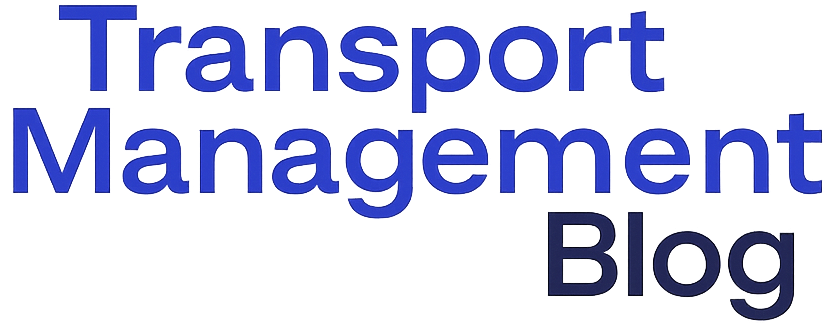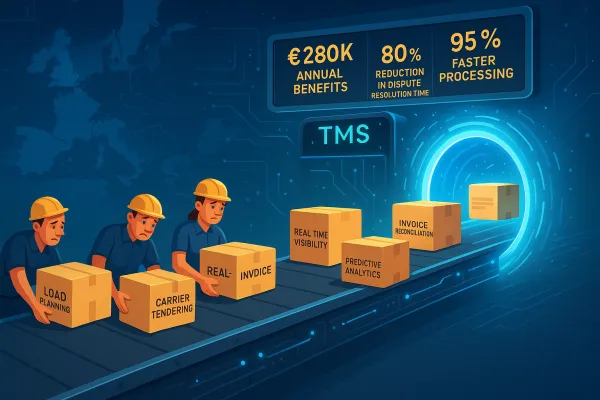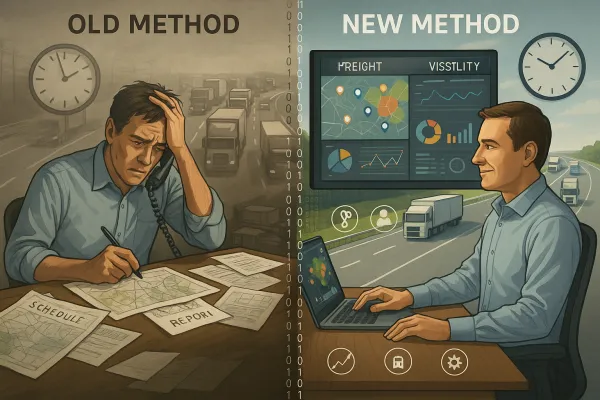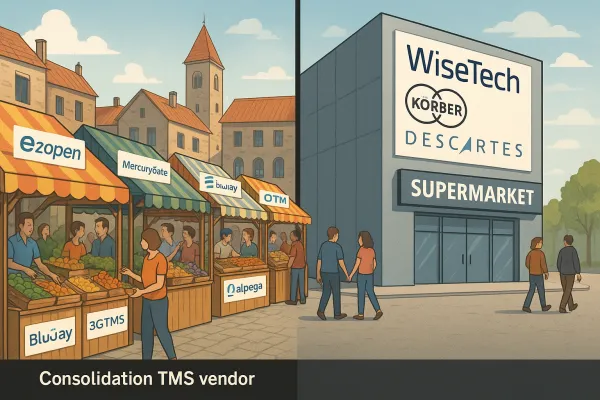Building the Perfect TMS Business Case: A European Shipper's Guide to Securing Budget Approval in 2025
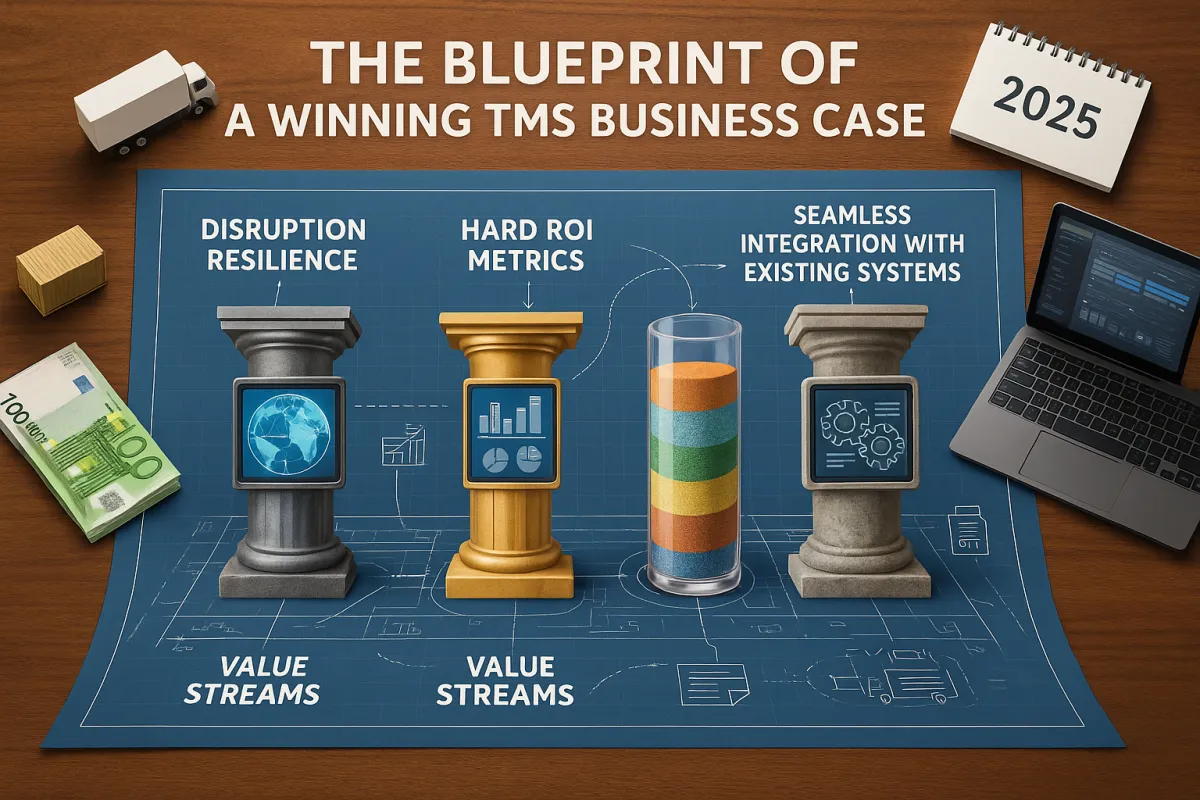
For European transport and logistics managers heading into 2025, securing budget approval for a Transport Management System (TMS) requires more than promising "efficiency gains" and "better visibility." 76% of logistics transformations fail to achieve their performance objectives. The difference between success and failure? A methodical approach to measuring return on investment, based on concrete and verifiable metrics.
After reviewing over 200 TMS business cases across different platforms, one pattern emerges: companies that treat their TMS business case like a financial investment proposal get approved. Those that rely on vague operational benefits don't.
Why TMS Business Cases Fail (And Why 2025 Is Different)
The failure rate isn't surprising when you examine typical TMS proposals. Most contain phrases like "improved efficiency," "better visibility," and "enhanced collaboration" without quantifying the financial impact. CFOs see through this immediately.
Compare that to successful cases we've seen from companies implementing solutions from Cargoson, Manhattan Active, or SAP TM. They start with specific numbers: "Current freight spend: €2.1M annually. Target reduction: €315K year one through route optimization and carrier selection."
By deploying a TMS, statistics show that most companies see ROI within 6–18 months, depending on the scale of the implementation and initial investment. But here's what makes 2025 different from previous years: management expects proof upfront, not promises of future measurement.
The companies failing with their business cases make three recurring mistakes:
- Calculating ROI based on maximum theoretical savings instead of realistic benchmarks
- Ignoring implementation costs beyond software licensing
- Underestimating the time required for user adoption and process changes
Successful implementations from Transporeon, Oracle TM, and Alpega share common traits: conservative ROI projections, comprehensive cost accounting, and realistic timelines. The difference lies in treating the TMS as a business investment, not a technology purchase.
The 2025 Context: Why Management Is More Skeptical Than Ever
In a context where logistics costs explode by 5.5% and where driver shortage affects 50,000 positions in France, every euro invested in digitalization must be justified by measurable gains. Leaders now demand tangible proof before validating IT budgets, particularly in transport where margins are shrinking.
This skepticism stems from recent experience. European manufacturers watched supply chain investments during 2020-2022 deliver mixed results. Some TMS implementations took 18 months instead of 6. Others required expensive customizations not included in initial budgets.
The eFTI regulation adds another layer of complexity. As of 9 July 2027: The eFTI Regulation will apply in full. Member State authorities must accept information shared electronically by operators via certified eFTI platforms. This creates both pressure and opportunity for TMS investments.
Finance teams now ask harder questions: "How do you measure success beyond freight cost reduction? What happens if adoption rates don't meet projections? How does this prepare us for regulatory compliance without additional investment?"
Your business case needs to address this new reality. That means building in contingencies, showing multiple value streams, and demonstrating how the TMS investment supports broader business objectives beyond transport optimization.
The Four Pillars of a Winning TMS Business Case
Pillar 1: Disruption Resilience (The New Priority)
Supply chain resilience has moved from nice-to-have to business critical. More than 76% of the businesses have seen supply chain disruption having a knock-on effect and causing delays to their operations in the past 12 months. One fifth (22%) of the businesses counted more than 20 disruptive incidents over the past 12 months, and 1 in 3 businesses subsequently had difficulty securing necessary materials for production.
This shifts your TMS business case from cost optimization to risk mitigation. Frame your investment around business continuity, not just efficiency. Show how manual processes failed during disruptions while automated systems adapted.
When building this pillar, quantify the cost of disruption. If a typical incident causes 2 days of delayed shipments affecting €50K in revenue, and you experience 8 incidents annually, that's €400K in disruption cost. A TMS that reduces response time from 24 hours to 4 hours through automated rerouting and carrier switching pays for itself through disruption avoidance.
Different platforms approach resilience differently. MercuryGate emphasizes real-time optimization, Descartes focuses on network visibility, and Cargoson provides cloud-native agility for rapid deployment during crises. Choose examples that match your specific vulnerability profile.
Pillar 2: Hard ROI Metrics That CFOs Actually Care About
Let's work through a concrete example that finance teams understand. A European manufacturer with €2M annual transport spend invests €200K in a TMS implementation. The annual gains break down to:
- €85K in fuel savings through route optimization (4.25% of transport spend)
- €120K in productivity gains from automated planning (equivalent to 1.5 FTE transport coordinators)
- €25K in dispute reduction through improved documentation
- €50K in additional revenue from faster customer deliveries
Total annual benefit: €280K. Net ROI: (€280K - €200K) / €200K = 40%
A well-optimized TMS typically generates 15 to 25% kilometer savings, but these gains can vary from 5% on already well-optimized routes to 40% on historically poorly planned routes. In 2025, with an average cost of €0.45 per kilometer for a utility vehicle, each kilometer saved represents a direct measurable gain.
The key is supporting each number with benchmarks. Route optimization savings come from pre-implementation analysis. Productivity gains require documenting current manual processes and showing exactly where automation replaces human effort.
Implementation speed matters for ROI timing. Cloud-native solutions like Cargoson report 6-12 weeks to value, while enterprise platforms like Blue Yonder might require 6-12 months. Factor this into your cash flow projections.
Pillar 3: Regulatory Compliance as Strategic Advantage
It could save the EU transport and logistics sector up to €1 billion per year. By creating common standards and making systems work together, eFTI paves the way for fully paperless transport in the EU.
The eFTI regulation creates a compelling compliance argument for TMS investment. Instead of viewing regulatory requirements as additional cost, frame them as competitive advantage. Early adopters gain operational benefits while competitors scramble to meet compliance deadlines.
Your business case should position the TMS as insurance against regulatory risk. Non-compliance costs include fines, delayed shipments at customs, and manual workarounds when paper processes fail. A TMS with built-in eFTI compliance eliminates these risks while providing operational benefits.
Platform readiness varies significantly. Oracle TM and SAP TM are developing eFTI modules, while Transporeon emphasizes API connectivity for compliance data sharing. Cargoson focuses on cloud-native architecture that adapts quickly to new regulatory requirements. Choose based on your implementation timeline and compliance priorities.
Pillar 4: Implementation Speed and User Adoption
Your TMS delivers value only when people actually use it. The reality on the ground is unequivocal: only 24% of companies manage to clearly demonstrate the financial impact of their TMS. The others navigate blindly, unable to quantify their gains or identify priority optimization levers.
Adoption is a leading indicator for ROI. Target >80% adoption within the first year, measured by the percentage of bookings actually made through the TMS versus email and Excel workarounds.
Implementation speed directly impacts ROI timing. Cloud-native platforms like FreightPOP, Shippo, and Cargoson typically deploy in 6-12 weeks, while enterprise solutions like Manhattan Active might require 6-12 months for full rollout.
But speed isn't everything. User experience determines long-term success. Transport planners under pressure will revert to familiar tools if the new system isn't intuitive. Include user training costs and change management support in your business case.
Measure adoption through system usage metrics: login frequency, transactions completed, and user satisfaction scores. These leading indicators predict whether your ROI projections will materialize.
The Template: Your Ready-to-Use Business Case Framework
Your TMS business case needs a structure that finance teams recognize. Here's the framework used by successful implementations:
Executive Summary (1 page)
Problem statement: Specific pain points with current transport operations
Solution overview: TMS capabilities that address each pain point
Financial impact: Total investment, annual benefits, ROI percentage
Implementation timeline: Key milestones and go-live date
Risk mitigation: How the TMS reduces operational and compliance risks
Current State Analysis (2 pages)
Transport spend breakdown by mode, lane, and carrier
Process inefficiencies with time and cost quantification
Manual effort in hours per week with fully-loaded cost
Disruption frequency and average cost per incident
Compliance gaps and associated risks
Solution Design (2 pages)
Core TMS functionality mapped to business requirements
Integration points with existing ERP and WMS systems
Vendor comparison showing capabilities and costs
Implementation approach and resource requirements
Financial Analysis (2 pages)
Total cost of ownership over 3 years
Annual benefits by category with supporting benchmarks
ROI calculation and payback period
Sensitivity analysis showing impact of adoption rates
Include vendor comparisons showing different approaches. Mention Cargoson's cloud-native deployment alongside established players like Manhattan Active to demonstrate thorough market analysis.
Common Objections and How to Counter Them
Finance teams raise predictable objections. Prepare responses for each:
"We can manage with Excel and email"
Counter with the cost of manual processes. If transport coordinators spend 15 hours weekly on manual tasks at €60K annual salary, that's €22K in opportunity cost annually. TMS automation frees this capacity for strategic work.
"Implementation risk is too high"
Address with phased rollout plans and vendor references. Cloud solutions like Cargoson offer lower implementation risk than on-premise systems. Start with a pilot covering 20% of shipments before full rollout.
"ROI calculations seem optimistic"
Provide conservative estimates with benchmark data. Direct savings, including reduction in accessorial fees, and decreased freight costs through optimized routes and load consolidation. Indirect savings including reduction in detention fees and time saved in planning and execution using the TMS.
"Budget timing isn't right"
Frame as investment in business continuity, not discretionary spending. Show how TMS capabilities prevent disruptions that cost more than the implementation investment.
Each objection becomes easier to handle when your business case includes specific data, vendor comparisons, and realistic timelines. The goal isn't to eliminate all concerns, but to demonstrate thorough analysis and risk mitigation.
Your next step: Use this framework to build your business case, but customize it for your specific situation. Include your actual transport data, realistic benchmarks for your industry, and vendor options that match your technical requirements. The companies getting approval in 2025 are those showing CFOs exactly how their TMS investment delivers measurable business value from day one.
